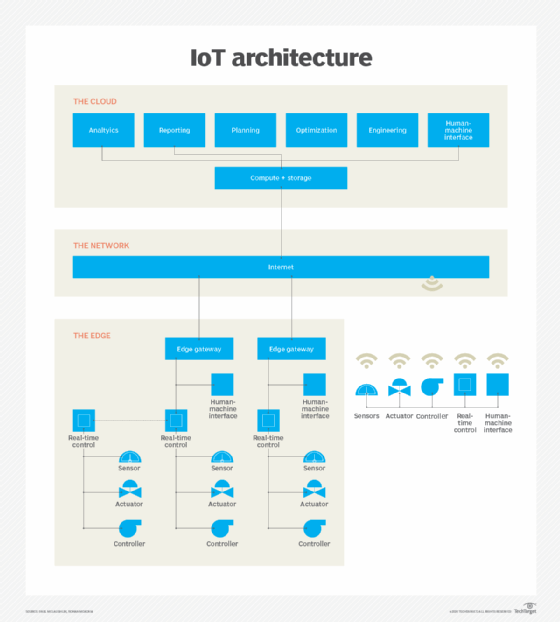
Oleksiy Mark - Fotolia
Get to know cloud IoT services on AWS, Azure and Google Cloud
Use this rundown of IoT offerings from AWS, Microsoft and Google to help decide which best suits your needs for collecting, processing and analyzing device data in the cloud.
AWS, Microsoft and Google offer a range of cloud IoT services, as each tries to gain a foothold in this emerging market. It's up to IT teams and entrepreneurs inside businesses to analyze what's out there and determine which service best meets their needs.
The IoT cloud market is roughly comparable to the overall IaaS market with this trio, according to Ezra Gottheil, principal analyst at TBR. AWS is the leader and still developing more cloud IoT services; Microsoft is second but growing at a rapid pace after its late start in the competition; and Google is next behind those two.
"They're adding cloud services that enhance the value of your IoT application and they're racing to do it," Gottheil said.
Some common use cases have begun to emerge where the cloud is a fit for IoT, Gottheil said. This includes mobile, shadow IoT with a cloud back end and geographically distributed end points that can be collected locally before being transferred to the cloud, like data from farm equipment sensors.
Many other large IT providers have entered the IoT market, including IBM, SAP and Oracle, but those vendors largely play to their strengths, with specialized capabilities targeted at existing customers. Conversely, AWS, Microsoft and Google have treated IoT as an opportunity to add another set of tools to their general-purpose infrastructure platforms, Gottheil said. They're also slowly building out edge services that extend beyond their core systems and provide on-premises hubs to gather and process data.
Continue reading for a high-level overview of the IoT services available on AWS, Microsoft Azure and Google Cloud.

AWS
AWS IoT Analytics: This managed service handles many of the manual tasks associated with IoT data analysis, including filtering and processing data. It can also layer on device metadata -- such as location or device type -- before the collective information is placed in a time-series data store. Analysts can run queries with the service's SQL engine, and developers can use AWS' prebuilt models designed specifically for IoT analysis and AI inference, or they can incorporate their own custom models.
AWS IoT Core: This service is the central cog in AWS' suite of IoT tools. It processes and routes messages between devices and AWS endpoints, including services for storage and analysis such as Amazon S3, SageMaker and QuickSight. It supports messages through Hypertext Transfer Protocol (HTTP), WebSockets and MQ Telemetry Transport (MQTT) communications. IoT Core also stores connected devices' latest state so the state can be read when a device is disconnected, and it has authentication checkpoints for security purposes.
AWS IoT Events: This managed service monitors devices for indicators of potentially complex problems. Developers define the logic to detect events, such as temperature sensors identifying HVAC system failures. Once an issue is uncovered, it can send alerts or automatically trigger corrective action.
AWS IoT Device Defender: Use this managed service to secure IoT workloads on AWS. Device Defender checks configurations -- such as device authentication and authorization -- against best practices and sends alerts if anything is out of compliance. This service also monitors devices and AWS IoT Core metrics that run counter to predefined characteristics.
AWS IoT Device Management: This service provides a registry to group devices and manage permissions. Data is stored in JSON files, and developers can also use IoT Device Management to monitor devices, analyze state and send firmware updates.
Amazon FreeRTOS: Amazon FreeRTOS is an open source OS for microcontrollers included on connected devices that need to securely perform simple tasks. Based on the FreeRTOS kernel, it includes libraries to connect small devices to AWS' suite of IoT services or other edge devices.
AWS IoT Greengrass: With this service, developers can extend their AWS deployments to the edge through Lambda functions or Docker containers. It performs compute tasks locally, such as data collection or executions based on machine learning models, even when devices have limited connectivity. Greengrass can then send that data to the AWS public cloud for storage and analysis. The software has also been incorporated into AWS Snowball Edge.
AWS IoT SiteWise: The things part of the internet of things covers all matters of device types, from household appliances to large-scale industrial equipment. SiteWise is specialized for the latter, with gateways that securely connect to on-premises servers to automatically collect, organize and process data. It can also connect to the latest industrial machines to collect data through APIs or MQTT messages. The collected data can then be analyzed against common industrial metrics to optimize the operation of that equipment.
AWS IoT Things Graph: A lack of device hardware and software standards adds complexity for developers looking to link disparate devices to their IoT workloads. IoT Things Graph abstracts protocols, interfaces and other lower-level details from the user to simplify integrations with the AWS cloud.
Microsoft Azure
Azure IoT Central: This SaaS offering is best suited for IT teams that want to offload infrastructure management tasks to their cloud provider. Through a web UI, developers create rules, monitor devices and manage IoT apps. It also includes prebuilt templates for healthcare, retail, energy and government sectors.
Azure IoT Edge: Built on top of Azure IoT Hub, this service can run containerized IoT workloads outside of Microsoft's public cloud. Edge devices can handle more compute tasks locally, which reduces ingress and egress with Azure and enables devices to continue to operate offline. With this service, a data scientist can conduct machine learning modeling in the cloud, then run those models at an edge location.
Azure IoT Hub: Like AWS IoT Core, this centralized communication back end connects fleets of devices with public cloud services. The service handles authentication, state management and automated provisioning at scale. It can integrate with Azure Event Grid to run serverless IoT applications.
Azure Digital Twins: Digital Twins models physical environments with spatially aware graphs. This service pulls in data from sensors in a real-world setting to gauge how people, places or devices might interact. The data from the virtual setting can then be used to find efficiencies or make improvements to the actual spaces.
Azure Sphere: Layer security into your Azure IoT deployment with this service. Azure Sphere incorporates certified microcontrollers, a specialized OS and cloud-based security software tools. It authenticates communication between devices, as well as between devices and the cloud. It also provides information about emerging threats identified across the Azure Sphere ecosystem.
Azure Security Center for IoT: With this service, IT teams can use agentless or agent-based monitoring to centralize security for IoT applications and hybrid cloud workloads. It handles threat detection and analyzes connected devices, as well as IoT Edge and IoT Hub.
Azure IoT solutions accelerator: These accelerators are open source code bases built to securely address several common IoT deployment scenarios -- remote monitoring, predictive managements, connected factories and device simulation. They're modular and customizable, and Microsoft is in the process of moving IoT solutions accelerators from a model-view-controller architecture to a microservices architecture.
Azure Time Series Insights: An IoT-specific analytics service, Time Series Insights ingests data without developers having to do any data prep. Users can perform ad hoc queries on streaming and historical device data, and the service provides several ways to sort and contextualize data for analysis.
Google Cloud
Cloud IoT Core: Google's IoT service collects, manages and ingests data from connected devices. Cloud IoT Core runs on top of Cloud Pub/Sub to combine data streams, which can then be analyzed in Cloud Dataflow, BigQuery, Cloud Bigtable and more. It supports MQTT and HTTP communications and scales automatically based on demand. Cloud IoT confirms device identity and authenticates devices when connected.
Edge TPU: This application-specific integrated circuit, or ASIC, was built to run AI capabilities in edge locations through a combination of hardware, software and AI algorithms. Edge TPUs are focused on machine learning inference at the edge, and they're intended to complement Google's cloud-based TPUs, creating an end-to-end AI stack.






